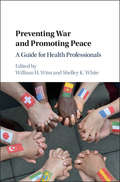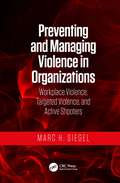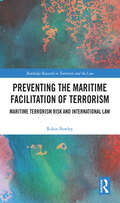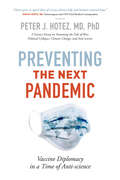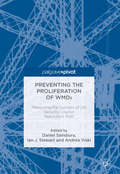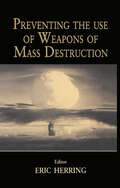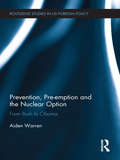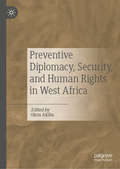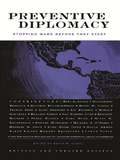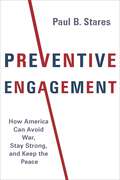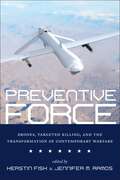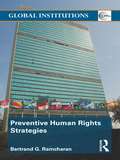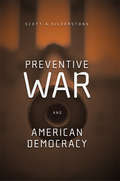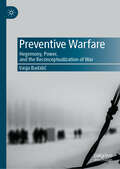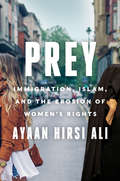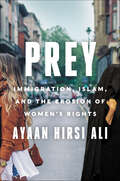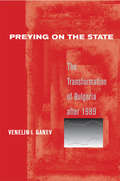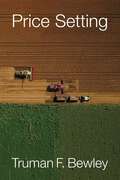- Table View
- List View
Preventing War and Promoting Peace: A Guide for Health Professionals
by William H. Wiist Shelley K. WhitePreventing War and Promoting Peace: A Guide for Health Professionals is an interdisciplinary study of how pervasive militarism creates a propensity for war through the influence of academia, economic policy, the defense industry, and the news media. Comprising contributions by academics and practitioners from the fields of public health, medicine, nursing, law, sociology, psychology, political science, and peace and conflict studies, as well as representatives from organizations active in war prevention, the book emphasizes the underlying preventable causes of war, particularly militarism, and focuses on the methods health professionals can use to prevent war. Preventing War and Promoting Peace provides hard-hitting facts about the devastating health effects of war and a broad perspective on war and health, presenting a new paradigm for the proactive engagement of health professions in the prevention of war and the promotion of peace.
Preventing War: The United Nations and Macedonia
by Abiodun WilliamsDescribes the role the UN played in Macedonia.
Preventing a Biochemical Arms Race
by Alexander Kelle Kathryn Nixdorff Malcolm DandoPreventing a Biochemical Arms Raceresponds to a growing concern that changes in the life sciences and the nature of warfare could lead to a resurgent interest in chemical and biological weapons (CBW) capabilities. By bringing together a wide range of historical material and current literature in the field of CBW arms control, the book reveals how these two disparate fields might be integrated to precipitate a biochemical arms race among major powers, rogue states, or even non-state actors. It seeks to raise awareness among policy practitioners, the academic community, and the media that such an arms race may be looming if developments are left unattended, and to provide policy options on how it - and it's devastating consequences - could be avoided. After identifying weaknesses in the international regime structures revolving around the Biological Weapons and Chemical Weapons Conventions, it provides policy proposals to deal with gaps and shortcomings in each prohibition regime individually, and then addresses the widening gap between them.
Preventing and Countering Extremism and Terrorist Recruitment: A Best Practice Guide
by Hanif QadirHanif Qadir is recognised as one of the world's leading specialists in positively transforming violent extremists. He has worked with hundreds of high-risk terrorist and violent extremist cases and has challenged many known figureheads who lead violently extreme groups both at home and abroad. In this essential book for all those who work with young people, Hanif outlines the push and pull factors and the early indicators of radicalisation, and offers decisive and unambiguous advice on how and when to intervene. The book includes anonymous case studies of a wide variety of people Hanif has personally worked with and lays down simple lessons on what success and failure looks like when tackling extremism.
Preventing and Countering Extremism and Terrorist Recruitment: A Best Practice Guide
by Hanif QadirHanif Qadir is recognised as one of the world's leading specialists in positively transforming violent extremists. He has worked with hundreds of high-risk terrorist and violent extremist cases and has challenged many known figureheads who lead violently extreme groups both at home and abroad. In this essential book for all those who work with young people, Hanif outlines the push and pull factors and the early indicators of radicalisation, and offers decisive and unambiguous advice on how and when to intervene. The book includes anonymous case studies of a wide variety of people Hanif has personally worked with and lays down simple lessons on what success and failure looks like when tackling extremism.
Preventing and Countering Violent Extremism and Radicalisation: Evidence-Based Policy and Practice
by Michael Lewis Jerzy Sarnecki Jane L. Ireland Leena Malkki Gustav Grut Sören Henrich Erin Lawlor Gema Varona Irina Van Der Vet Simon Fulgoni Susanna MenisEPUB and EPDF available open access under CC-BY-NC-ND licence. How can we use evidence to improve deradicalisation and violence prevention outcomes? Based on work developed during the implementation of the cross-European INDEED project, this is an essential reference book for practitioners, researchers and policy makers. It sets out the three pillars of best evidence-based practice – scientific evidence, professional judgement and consideration of clients’ preferences, values and beliefs. Demonstrating both successful and unsuccessful approaches with case studies from the field, the book offers practical strategies for prevention teams designing and evaluating their programmes.
Preventing and Countering Violent Extremism: Designing and Evaluating Evidence-Based Programs (Political Violence)
by Michael J. WilliamsThis textbook serves as a guide to design and evaluate evidence-based programs intended to prevent or counter violent extremism (P/CVE). Violent extremism and related hate crimes are problems which confront societies in virtually every region of the world; this text examines how we can prevent or counter violent extremism using a systematic, evidence-based approach. The book, equal parts theoretical, methodological and applied, represents the first science-based guide for understanding “what makes hate,” and how to design and evaluate programs intended to prevent this. Though designed to serve as a primary course textbook, the work can readily serve as a how-to guide for self-study, given its abundant links to freely available online toolkits and templates. As such, it is designed to inform both students and practitioners alike with respect to the management, design, or evaluation of programs intended to prevent or counter violent extremism. Written by a leading social scientist in the field of P/CVE program evaluation, this book is rich in both scientific rigor and examples from the “real world” of research and evaluation dedicated to P/CVE. This book will be essential reading for students of terrorism, preventing or countering violent extremism, political violence, and deradicalization, and highly recommended for students of criminal justice, criminology, and behavioural psychology.
Preventing and Managing Violence in Organizations: Workplace Violence, Targeted Violence, and Active Shooters
by Marc H. SiegelOrganizations of all types and sizes, whether they are a business, educational institution, healthcare provider, or house-of-worship, need to plan for the possibility of violent acts that may impact its people, assets, and activities. Preventing and Managing Violence in Organizations: Workplace Violence, Targeted Violence, and Active Shooters provides a comprehensive approach to addressing workplace violence, active shooter and assailant events, and other forms of targeted violence. The book takes a unique perspective that the prevention and management of violence in an organization is a risk and business management issue, rather than a siloed security issue. As such, the book’s objective is to help organizations develop a program for preventing and managing violence that can be integrated into their day-to-day overall business management approach. The main theme of the book is that any program to prevent and manage violence in an organization needs to be an inclusive process: where everyone in the organization is viewed as a risk maker and risk taker, and therefore, a risk manager. The emphasis is on building a risk and security awareness culture in the organization so that everyone throughout the organization is aware and part of the solution. The book recognizes that many, if not most, organizations do not have a dedicated chief security officer to oversee the prevention and management of violence. It also recognizes that many resource allocation decisions are made by business managers, not the security manager. While other books approach this issue from a security perspective, this book takes the perspective that providing a safe and secure environment within the organization, and protecting its people, assets, and activities, is a business management imperative. Therefore, the book emphasizes the need to promote a risk and security awareness culture that is integrated into the organization's system of management and all its activities and functions. The "Introduction" section of the book includes a brief description of violence in organizations and the imperative for integrating the prevention and management of violence into the organization’s overall business management strategy. The "Framework" section helps business, human resource, risk, security, and safety managers build a programmatic framework to support prevention and management of violence in all the organizations activities. The "Tactics and Control Measures" section provides tactical and operational advice and tools on methods to prevent, respond to, and recover from potentially violent events. For organizations that have adopted an ISO, Robust Process Improvement, or Six-Sigma management systems approach, they will immediately recognize that the elements described in the framework can be integrated seamlessly into their overall management system approach. Preventing and Managing Violence in Organizations illustrates a systems approach for preventing and managing violence in organizations that can also be used for managing other types of operational risks. Security managers will find the book useful for integrating security in the organization’s day-to-day activities—as an integral part of these activities—rather than an add-on activity. Security professionals will be able to present their program from a business and risk management perspective.
Preventing the Maritime Facilitation of Terrorism: Maritime Terrorism Risk and International Law (Routledge Research in Terrorism and the Law)
by Robin BowleyIn the aftermath of the 9/11 attacks, concerns that terrorists might utilise vessels to transport weaponry, terrorist operatives and/or to finance their activities prompted several international legal developments. This book evaluates the extent to which the international maritime security measures developed following the 9/11 attacks would be likely to prevent the utilisation of vessels to facilitate terrorist activities. It considers the likely effectiveness of the International Ship and Port Facility Security Code for improving vessel and port security, and the 2005 Protocol to the Convention for the Suppression of Unlawful Acts Against Maritime Navigation in facilitating the interdiction of suspected terrorist vessels. It also explains how the US-led Proliferation Security Initiative - a cooperative effort through which participant governments agree to prevent the illicit transfers of Weapons of Mass Destruction and related materials – has provoked debate about the legality of vessel interdictions under the United Nations Convention on the Law of the Sea (the LOSC). After exploring alternative interpretations of the LOSC, and states’ self-defence rights under Article 51 of the Charter of the United Nations, it formulates suggested guidelines for the unilateral interdiction of suspected terrorist support vessels in exceptional circumstances. The book also discusses the relevant recommendations by the OECD’s Financial Action Taskforce for preventing the financing of terrorism, and the national maritime security legislation for preventing the maritime facilitation of terrorist activities in the United Kingdom and in Australia. The book concludes by emphasising the importance of the continual active implementation of ship, port facility and supply chain security measures, and of further enhancing international cooperation to facilitate vessel interdictions. It will be of interest to those working in the areas of Law and Terrorism, Law of the Sea, Maritime Law and Insurance and International Law.
Preventing the Next Pandemic: Vaccine Diplomacy in a Time of Anti-science
by Peter J. HotezThe last five years saw a significant return of epidemic infectious disease, culminating in COVID-19. In our new post–COVID-19 world, how do we prevent future illnesses by expanding scientific and vaccine diplomacy and cooperation, especially to combat the problems that humans have brought on ourselves?Modern diseases and viruses have been spurred anew by war and conflict as well as shifting poverty, urbanization, climate change, and a new troubling anti-science/anti-vaccination outlook. From such twenty-first-century forces, we have seen declines in previous global health gains, with sharp increases in vaccine-preventable and neglected diseases on the Arabian Peninsula, in Venezuela, in parts of Africa, and even on the Gulf Coast of the United States. In Preventing the Next Pandemic, international vaccine scientist and tropical disease and coronavirus expert Peter J. Hotez, MD, PhD, argues that we can—and must—rely on vaccine diplomacy to address this new world order in disease and global health. Detailing his years in the lab developing new vaccines, Hotez also recounts his travels around the world to shape vaccine partnerships with people in countries both rich and poor in an attempt to head off major health problems. Building on the legacy of Dr. Albert Sabin, who developed the oral polio vaccine with Soviet scientists at the height of the Cold War, he explains how he is still working to refresh and redirect vaccine diplomacy toward neglected and newly emerging diseases. Hotez reveals how—during his Obama-era tenure as the US Science Envoy for the Middle East and North Africa, which coincided with both the rise in these geopolitical forces and climate change—he witnessed tropical infectious diseases and established vaccine partnerships that may still combat them up close. He explores why, since 2015, we've seen the decline of global cooperation and cohesion, to the detriment of those programs that are meant to benefit the most vulnerable people in the world. Unfortunately, Hotez asserts, these negative global events kick off a never-ending loop. Problems in a country may lead to disease outbreaks, but those outbreaks can lead to further problems—such as the impact of coronavirus on China's society and economy, which has been felt around the globe. Zeroing in on the sociopolitical and environmental factors that drive our most controversial and pressing global health concerns, Hotez proposes historically proven methods to soothe fraught international relations while preparing us for a safer, healthier future. He hammers home the importance of public engagement to communicate the urgency of embracing science during troubled times. Touching on a range of disease, from leishmaniasis, schistosomiasis, and Middle East Respiratory Syndrome (MERS) to COVID-19, Preventing the Next Pandemic has always been a timely goal, but it will be even more important in a COVID and post-COVID world.
Preventing the Proliferation of WMDs: Measuring The Success Of Un Security Council Resolution 1540
by Daniel Salisbury Ian J. Stewart Andrea ViskiThis edited volume provides a fresh analysis for researcher and practitioners regarding United Nations Security Council resolution 1540, the status of its implementation, and its future by providing an original evaluation of progress in implementation and challenges faced during the resolution’s first decade. In doing so, the book will consider the resolution’s utility as a non-proliferation tool with a view to identifying what further actions are required for the objectives and goals embodied by UNSCR 1540 to be achieved and sustained. The book progresses by exploring the history of the resolution, implementation trends, implementation from a regional perspective, challenges, and future ways forward. The book appeals to a wide readership of scholars, policymakers, and other stakeholders of the 1540 process.
Preventing the Use of Weapons of Mass Destruction
by Eric HerringThese studies concentrate on preventing the use of weapons of mass destruction. A common argument runs through all of the papers: that, while complacency must be avoided, much of the post-Cold War focus among Western governments on the threat posed by weapons of mass destruction is alarmist.
Prevention, Pre-emption and the Nuclear Option: From Bush to Obama (Routledge Studies in US Foreign Policy)
by Aiden WarrenDespite its portrayal as a bold departure, the Bush Doctrine was not the "new" or "revolutionary" policy instrument that many at the time portended. This work seeks to argue that while it was clear that the Bush Doctrine certainly qualified as a preventive war policy, it is apparent that the adoption of this strategy did not mark a total break with American tradition or earlier Administrations. Warren seeks to dispel arguments pertaining to the supposed "radical" nature of the Bush Doctrine – based on comparisons with previous National Security Strategies and previous Administrations’ penchant for prevention. However, the work also highlights that what was new and bold about the Bush Administration’s National Security Strategy of 2002, was its willingness to embrace reinvigorating a nuclear option that could ultimately be used in the context of preventive war. While Obama has struck bold rhetorical notes and promises in relation to limiting the role of nuclear weapons, he has stopped short of changing the status quo on critical issues that have lingered since the Cold War – such as tactical nuclear weapons and keeping missiles on alert. This book’s final section examines the extent to which Obama has attempted to ‘adjust’ the nuclear option with the recent release of the congressionally mandated Nuclear Posture Review (NPR). Offering new insights into the Bush doctrine and providing a comprehensive analysis of the current status of the US nuclear weapons strategy, this volume will be of great interest to scholars and students of American foreign policy, security studies and international relations.
Preventive Diplomacy, Security, and Human Rights in West Africa
by Okon AkibaThis edited volume focuses on the development and conflict prevention mechanism of the Economic Community of West African States, ECOWAS. The contributors discuss complex socio-political and economic issues and use a cross disciplinary approach to treat most of the dominant research questions in the field. The chapters come nicely together in a kaleidoscope of knowledge deriving from scholarly investigative traditions in political science, anthropology, economics, law, and sociology. The book is conceived as a source of reference and for graduate courses in African politics, development, human rights, transnational law, and international public policy.
Preventive Diplomacy: Stopping Wars Before They Start
by Kevin M. CahillThe suppression of war has been the primary objective of the United Nations for almost fifty years, and stopping a war before it starts is easier than ending a war already underway. History, however, has shown that military interventions and economic sanctions often do more harm than good. In Preventive Diplomacy, Nobel prize winners, top officials, and revered thinkers tackle these issues and explore the process of conflict prevention from humanitarian, economic, and political perspectives. This cross-disciplinary reader on global politics demonstrates that when new insights and methodologies on public health are applied to the handling of international disasters, the change in policy perspective is intriguing--even hopeful.
Preventive Engagement: How America Can Avoid War, Stay Strong, and Keep the Peace (A Council on Foreign Relations Book)
by Paul StaresThe United States faces an increasingly turbulent world. The risk of violent conflict and other threats to international order presents a vexing dilemma: should the United States remain the principal guarantor of global peace and security with all its considerable commitments and potential pitfalls––not least new and costly military entanglements––that over time diminish its capacity and commitment to play this vital role or, alternatively, should it pull back from the world in the interests of conserving U.S. power, but at the possible cost of even greater threats emerging in the future?Paul B. Stares proposes an innovative and timely strategy—“preventive engagement”—to resolve America’s predicament. This approach entails pursuing three complementary courses of action: promoting policies known to lessen the risk of violent conflict over the long term; anticipating and averting those crises likely to lead to costly military commitments in the medium term; and managing ongoing conflicts in the short term before they escalate further and exert pressure on the United States to intervene. In each of these efforts, forging “preventive partnerships” with a variety of international actors, including the United Nations, regional organizations, nongovernmental organizations, and the business community, is essential. The need to think and act ahead that lies at the heart of a preventive engagement strategy requires the United States to become less shortsighted and reactive. Drawing on successful strategies in other areas, Preventive Engagement provides a detailed and comprehensive blueprint for the United States to shape the future and reduce the potential dangers ahead.
Preventive Force: Drones, Targeted Killing, and the Transformation of Contemporary Warfare
by Jennifer M. Ramos Kerstin FiskExamines the recent rise in the United States' use of preventive forceMore so than in the past, the US is now embracing the logic of preventive force: using military force to counter potential threats around the globe before they have fully materialized. While popular with individuals who seek to avoid too many “boots on the ground,” preventive force is controversial because of its potential for unnecessary collateral damage. Who decides what threats are ‘imminent’? Is there an international legal basis to kill or harm individuals who have a connection to that threat? Do the benefits of preventive force justify the costs? And, perhaps most importantly, is the US setting a dangerous international precedent? In Preventive Force, editors Kerstin Fisk and Jennifer Ramos bring together legal scholars, political scientists, international relations scholars, and prominent defense specialists to examine these questions, whether in the context of full-scale preventive war or preventive drone strikes. In particular, the volume highlights preventive drones strikes, as they mark a complete transformation of how the US understands international norms regarding the use of force, and could potentially lead to a ‘slippery slope’ for the US and other nations in terms of engaging in preventive warfare as a matter of course. A comprehensive resource that speaks to the contours of preventive force as a security strategy as well as to the practical, legal, and ethical considerations of its implementation, Preventive Force is a useful guide for political scientists, international relations scholars, and policymakers who seek a thorough and current overview of this essential topic.
Preventive Human Rights Strategies (Global Institutions)
by Bertrand G. RamcharanThe prevention of violations of human rights must become the dominant protection strategy of the twenty-first century, nationally, regionally, and globally. This book clearly identifies the need for preventive human rights strategies, maps what exists by way of such strategies at the present time, and offers policy options to deal with the world of the future. Written by a former UN High Commissioner for Human Rights, the book suggests the future lies in strong national protection systems backed up by regional and international organs and an international criminal justice system. The book explores the future of preventive human rights through a wide range of contemporary issues, including: climate change pandemics mass migration global poverty and pervasive inequality inter-state conflicts terrorism, including WMD terrorism gross violations of human rights the financial and economic crisis We are already in a quite different world in the 21st century, and human rights thinking will need to evolve to meet its needs. This important and contemporary volume calls for the modification of current preventive human rights strategies, and is essential reading for all those concerned with the future of international relations and human rights.
Preventive War and American Democracy
by Scott SilverstoneThis volume explores the preventive war option in American foreign policy, from the early Cold War strategic problems created by the growth of Soviet and Chinese power, to the post-Cold War fears of a nuclear-armed North Korea, Iraq and Iran. For several decades after the Second World War, American politicians and citizens shared the belief that a war launched in the absence of a truly imminent threat or in response to another’s attack was raw aggression. Preventive war was seen as contrary to the American character and its traditions, a violation of deeply held normative beliefs about the conditions that justify the use of military force. This ‘anti-preventive war norm’ had a decisive restraining effect on how the US faced the shifting threat in this period. But by the early 1990s the Clinton administration considered the preventive war option against North Korea and the Bush administration launched a preventive war against Iraq without a trace of the anti-preventive war norm that was central to the security ethos of an earlier era. While avoiding the sharp partisan and ideological tone of much of the recent discussion of preventive war, Preventive War and American Democracy explains this change in beliefs and explores its implications for the future of American foreign policy.
Preventive Warfare: Hegemony, Power, and the Reconceptualization of War
by Vasja BadaličThis book provides a critical and comprehensive analysis of the reconceptualization of preventive warfare in the 21st Century. It discusses how the US launched and fought some wars to prevent future vague threats and how that practice has fundamentally undermined the legal system and the main principles of the use of force, in ways that not only further US dominance but shield powerful actors from accountability. The US redefined key legal concepts to set up a new legal framework for preventive warfare and, consequently, introduced new practices for carrying out preventive military operations. Drawing on a collection of case studies, on the changes in the jus ad bellum and jus in bello, focusing mainly on Afghanistan and Iraq and beyond, the book shows how violations of the law of war were persistently conducted in the 21st century by supposedly democratic countries who claimed to be upholding the law. It explores three types of preventive warfare – that is, preventive national self-defense, preventive on-the-spot reactions, and preventive “security” detention – to show how they blurred the line between civilians and legitimate military targets, and thus increased the risk of causing harm to civilians. The book speaks to students, scholars, and practitioners from the fields of criminology, law, international relations, political science, critical security studies, and critical military studies.
Prey: A Gripping Must-Read Thriller
by L.A. LarkinThe author of Devour delivers a gripping, globetrotting thriller “in the vein of a feminised Fleming or the Fox network’s adrenalin-fuelled series 24” (The Sydney Morning Herald).Four murders. Four countries. One terrible secret.Olivia Wolfe is a journalist who travels the world exposing heinous crimes. She has more enemies that most.When her anonymous source is killed, Wolfe must unravel the terrible secret that connects a series of gruesome murders. But powerful people want her stopped.Betrayed and isolated, Wolfe is hunted by a faceless killer. Can she stay alive long enough to expose the shocking truth?Praise for bestselling author L.A. Larkin“In Larkin, Michael Crichton has an heir apparent.” —The Guardian“L.A. Larkin is a world-class thriller writer.” —James Phelan, bestselling author of The Agency“Exciting, original and utterly captivating.” —Literature Works“Larkin’s fast action style is accompanied by impressive research.” —The Times“Action and intrigue in spades.” —Peter James, bestselling author of Left You Dead“Breakneck and exciting.” —Paul Mendelson, author of Apostle Lodge
Prey: Immigration, Islam, and the Erosion of Women's Rights
by Ayaan Hirsi AliWhy are so few people talking about the eruption of sexual violence and harassment in Europe’s cities? No one in a position of power wants to admit that the problem is linked to the arrival of several million migrants—most of them young men—from Muslim-majority countries.In Prey, the best-selling author of Infidel, Ayaan Hirsi Ali, presents startling statistics, criminal cases and personal testimony. Among these facts: In 2014, sexual violence in Western Europe surged following a period of stability. In 2018 Germany, “offences against sexual self-determination” rose 36 percent from their 2014 rate; nearly two-fifths of the suspects were non-German. In Austria in 2017, asylum-seekers were suspects in 11 percent of all reported rapes and sexual harassment cases, despite making up less than 1 percent of the total population. This violence isn’t a figment of alt-right propaganda, Hirsi Ali insists, even if neo-Nazis exaggerate it. It’s a real problem that Europe—and the world—cannot continue to ignore. She explains why so many young Muslim men who arrive in Europe engage in sexual harassment and violence, tracing the roots of sexual violence in the Muslim world from institutionalized polygamy to the lack of legal and religious protections for women. A refugee herself, Hirsi Ali is not against immigration. As a child in Somalia, she suffered female genital mutilation; as a young girl in Saudi Arabia, she was made to feel acutely aware of her own vulnerability. Immigration, she argues, requires integration and assimilation. She wants Europeans to reform their broken system—and for Americans to learn from European mistakes. If this doesn’t happen, the calls to exclude new Muslim migrants from Western countries will only grow louder. Deeply researched and featuring fresh and often shocking revelations, Prey uncovers a sexual assault and harassment crisis in Europe that is turning the clock on women’s rights much further back than the #MeToo movement is advancing it.
Prey: Immigration, Islam, and the Erosion of Women's Rights
by Ayaan Hirsi AliWhy are so few people talking about the eruption of sexual violence and harassment in Europe’s cities? No one in a position of power wants to admit that the problem is linked to the arrival of several million migrants—most of them young men—from Muslim-majority countries.In Prey, the best-selling author of Infidel, Ayaan Hirsi Ali, presents startling statistics, criminal cases and personal testimony. Among these facts: In 2014, sexual violence in Western Europe surged following a period of stability. In 2018 Germany, “offences against sexual self-determination” rose 36 percent from their 2014 rate; nearly two-fifths of the suspects were non-German. In Austria in 2017, asylum-seekers were suspects in 11 percent of all reported rapes and sexual harassment cases, despite making up less than 1 percent of the total population. This violence isn’t a figment of alt-right propaganda, Hirsi Ali insists, even if neo-Nazis exaggerate it. It’s a real problem that Europe—and the world—cannot continue to ignore. She explains why so many young Muslim men who arrive in Europe engage in sexual harassment and violence, tracing the roots of sexual violence in the Muslim world from institutionalized polygamy to the lack of legal and religious protections for women. A refugee herself, Hirsi Ali is not against immigration. As a child in Somalia, she suffered female genital mutilation; as a young girl in Saudi Arabia, she was made to feel acutely aware of her own vulnerability. Immigration, she argues, requires integration and assimilation. She wants Europeans to reform their broken system—and for Americans to learn from European mistakes. If this doesn’t happen, the calls to exclude new Muslim migrants from Western countries will only grow louder. Deeply researched and featuring fresh and often shocking revelations, Prey uncovers a sexual assault and harassment crisis in Europe that is turning the clock on women’s rights much further back than the #MeToo movement is advancing it.
Preying On The State
by Venelin I. GanevImmediately after 1989, newly emerging polities in Eastern Europe had to contend with an overbearing and dominant legacy: the Soviet model of the state. At that time, the strength of the state looked like a massive obstacle to change; less than a decade later, the state's dominant characteristic was no longer its overweening powerfulness, but rather its utter decrepitude. Consequently, the role of the central state in managing economies, providing social services, and maintaining infrastructure came into question. Focusing on his native Bulgaria, Venelin I. Ganev explores in fine-grained detail the weakening of the central state in post-Soviet Eastern Europe. Ganev starts with the structural characteristics of the Soviet satellites, and in particular the forms of elite agency favored in the socialist party-state. As state socialism collapsed, Ganev demonstrates, its institutional legacy presented functionaries who had become accustomed to power with a matrix of opportunities and constraints. In order to maximize their advantage under such conditions, these elites did not need a robust state apparatus-in fact, all of the incentives under postsocialism pushed them to subvert the infrastructure of governance. Throughout Preying on the State, Ganev argues that the causes of state malfunctioning go much deeper than the policy preferences of "free marketeers" who deliberately dismantled the state. He systematically analyzes the multiple dimensions, implications, and significance of the institutional and social processes that transformed the organizational basis of effective governance.
Price Setting
by Truman F. BewleyThe prices of some products fluctuate dramatically, while others remain more constant. What accounts for these extreme differences? Renowned economist Truman F. Bewley investigates and elucidates this puzzling problem. Its crux, he argues, is that differentiated product prices are usually stable, whereas the prices of undifferentiated products – for which buyers can easily find comparable substitutes – are often volatile. Although product differentiation gives producers market power, this power alone does not guarantee price stability. There are nearly undifferentiated products whose producers have market power yet for which prices are unstable. Weakness of product differentiation makes it so advantageous for producers to compete on price that they do so and forego the benefits and stability of price collusion. Producers of truly differentiated goods prefer to compete on product performance rather than price and find that reducing prices during recessions does little to increase demand. Based on hundreds of interviews with businesspeople responsible for setting prices, Bewley’s book is an unusual and groundbreaking work, with findings vital for economists, students, and policymakers.
